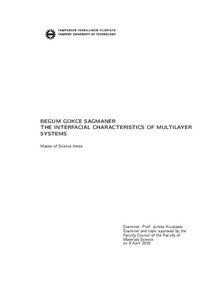The Interfacial Characteristics of Multilayer Systems
Begum Gökce, Sagmaner (2016)
Begum Gökce, Sagmaner
2016
Master's Degree Programme in Materials Science
Teknisten tieteiden tiedekunta - Faculty of Engineering Sciences
This publication is copyrighted. You may download, display and print it for Your own personal use. Commercial use is prohibited.
Hyväksymispäivämäärä
2016-08-17
Julkaisun pysyvä osoite on
https://urn.fi/URN:NBN:fi:tty-201608084399
https://urn.fi/URN:NBN:fi:tty-201608084399
Tiivistelmä
The target of the study is to explore the opportunity of enhancing the adhesion of polyethylene terephthalate to the cardboard when the coating thickness of polyethylene terephthalate onto the cardboard is diminished. The reference coating weight is 40 g/m2 and the target is to achieve same great adhesion with between 25-30 g/m2 coating weight.
According to the purpose of the thesis, literature study includes principles of extrusion coating, differences in extrusion coating of polyesters and polyolefins, adhesion theories and practical methods for adhesion improvement in extrusion coating. Literature study is followed by an experimental part, where adhesion improvement by changing processing parameters, modifying process equipments and trying different grades of polyethylene terephthalate was studied once the coating weight is diminished.
In the experimental part of the study, 5 adhesion trials are performed. In adhesion trial 1 and 2, PET 1 grade is utilized and PET 2 grade is utilized in adhesion trial 3,4,5. Firstly, both grades of PET are screened by performing with only corona as a pretreatment method by following same processing parameters. In screening trials, process variable is air gap. In the following adhesion trials, the effect of flame treatment by performing with various air gap levels and the effect of process equipment modifications by performing with various line speeds are studied for both of them by following same processing parameters. After trials have done, samples are analyzed.
Analysis methods can be examined in two different groups: main and additional analysis methods. Main analysis methods are adhesion test by hand, grammage test and neck-in test. Additional analysis methods are heat sealing test, microscopy test and pinhole test. For the application of addditional test methods, it is decided that they will be performed if the adhesion level of polyethylene terephthalate on the cardboard reaches the level of 5 over 5 at the target coating weight. The best attained adhesion of PET 1 is the level of 4 over 5 by performing only with corona during the screening trial. Normally, the best adhesion results is expected from modifications of process equipments results. The most probable reason of the situation is high melt temperature that caused thermal degradation.
In the case of adhesion of PET 2 grade, the best adhesion level is 4 over of 5 while performing with modified process equipments. In addition, coating weight results of PET 2 obtained from common test points are generally out of the target coating weight range. This shows that it is possible to reach almost same adhesion level at lower coating weight levels by utilizing PET 2 grade.
All in all, it is proven that it is possible to run the process at 30g/m2 coating with almost perfect adhesion for both polyethylene terephthalate grades. Better adhesion can be achieved by performing with high line speeds, high screw speeds and minimum air gap values.
According to the purpose of the thesis, literature study includes principles of extrusion coating, differences in extrusion coating of polyesters and polyolefins, adhesion theories and practical methods for adhesion improvement in extrusion coating. Literature study is followed by an experimental part, where adhesion improvement by changing processing parameters, modifying process equipments and trying different grades of polyethylene terephthalate was studied once the coating weight is diminished.
In the experimental part of the study, 5 adhesion trials are performed. In adhesion trial 1 and 2, PET 1 grade is utilized and PET 2 grade is utilized in adhesion trial 3,4,5. Firstly, both grades of PET are screened by performing with only corona as a pretreatment method by following same processing parameters. In screening trials, process variable is air gap. In the following adhesion trials, the effect of flame treatment by performing with various air gap levels and the effect of process equipment modifications by performing with various line speeds are studied for both of them by following same processing parameters. After trials have done, samples are analyzed.
Analysis methods can be examined in two different groups: main and additional analysis methods. Main analysis methods are adhesion test by hand, grammage test and neck-in test. Additional analysis methods are heat sealing test, microscopy test and pinhole test. For the application of addditional test methods, it is decided that they will be performed if the adhesion level of polyethylene terephthalate on the cardboard reaches the level of 5 over 5 at the target coating weight. The best attained adhesion of PET 1 is the level of 4 over 5 by performing only with corona during the screening trial. Normally, the best adhesion results is expected from modifications of process equipments results. The most probable reason of the situation is high melt temperature that caused thermal degradation.
In the case of adhesion of PET 2 grade, the best adhesion level is 4 over of 5 while performing with modified process equipments. In addition, coating weight results of PET 2 obtained from common test points are generally out of the target coating weight range. This shows that it is possible to reach almost same adhesion level at lower coating weight levels by utilizing PET 2 grade.
All in all, it is proven that it is possible to run the process at 30g/m2 coating with almost perfect adhesion for both polyethylene terephthalate grades. Better adhesion can be achieved by performing with high line speeds, high screw speeds and minimum air gap values.
